|
Report
from
North America
Canadian imports of sawn tropical hardwood on the rise
Canada is a much smaller market than the US, and
Canadian tropical sawnwood imports have historically
been less than 10% of the volumes imported by the US.
Over the last ten years, however, Canadian imports have
slowly gone up and in 2010 the highest import volume to
date was recorded.
Canada imported 77,736 cu.m. of sawn tropical hardwood
in 2010 according to Statistics Canada, this represents
almost 40% of (the unusually low) US imports in 2010.
The Canadian Housing and Mortgage Corporation
forecasts declining housing starts and construction
expenditures for the next two years, so Canadian tropical
sawnwood imports are likely to stabilize and not continue
the strong growth seen in 2010.
When looking at the value of the sawnwood imported,
trade figures show that the Canadian market bought more
lower-value species and grades in the last three years than
the US. The average unit price dropped to approximately
half of that paid by US importers.
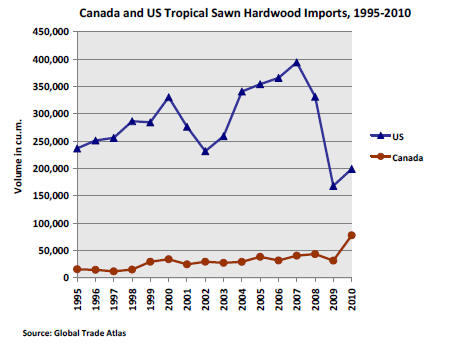
Canada and the US are very similar markets when it
comes to wood product end uses, although a few
differences exist that affect demand for tropical timber.
Both countries import tropical wood mainly in the form of
plywood and finished products such as flooring, moulding
and furniture. Canada¡¯s hardwood flooring manufacturers,
located mainly in the province of Quebec, are the key
users of sawn tropical hardwood.
Demand for tropical wood in exterior applications such as
decking is lower in Canada than in the US. Canada¡¯s
decking market is overall much smaller because a
significant and growing share of Canadians lives in
apartment buildings, while the vast majority of housing in
the US are single-family homes.
Canada also uses predominantly treated softwood for
decking and boardwalks, and there is less demand for
tropical wood or other, non-wood materials. An exception
is marine applications where softwoods are not suitable.
Canada does not have Lacey Act-type mandatory
requirements for wood to be legal, but in practice most
tropical timber imports come to Canada via US ports and
from distributors who need to adhere to the Lacey Act.
Statistics Canada distinguishes only few tropical species in
their sawnwood import data. Of the species shown, sapelli
accounts for the largest share in Canada¡¯s tropical
sawnwood imports.
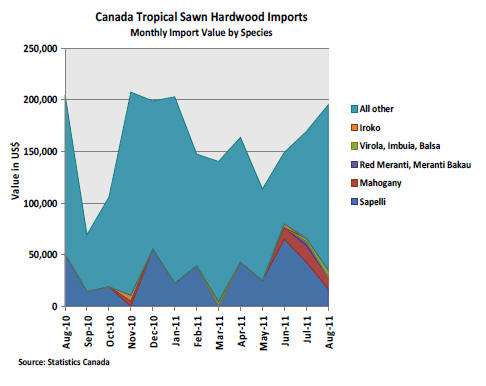
Tropical timber demand in the US slow to recover
It looks increasingly likely that 2011 will not see a
significant improvement in tropical timber consumption in
the US compared to the previous year.
Imports of tropical sawn hardwood are also trailing nontropical
hardwood imports. In August, year-to-date import
volumes of tropical sawn hardwood were just 2% above
the previous year, while temperate sawn hardwood
imports saw a 30% increase.
It is difficult to say what role the Lacey Act amendment is
playing in this slow recovery of tropical sawn hardwood
demand.
Tropical hardwood imports are still doing better than sawn
softwood imports, which are 7% below 2010 volumes.
Sawn hardwood also accounts for only a small share of US
tropical timber consumption. Most tropical wood comes
into the US as semi-finished or finished products, such as
plywood, moulding, flooring and furniture.
While overall tropical timber imports are at similar levels
as in 2010, some products saw large gains this year up to
August.
On the sawn hardwood side, imports of most species were
up, especially keruing, sapelli, ipe and cedro, while balsa
imports declined. Significant increases were also seen in
hardwood moulding imports from Brazil and Malaysia and
in hardwood flooring from Indonesia, Malaysia and China.
Imports of most sawn hardwood species down in August
In August, US tropical sawn hardwood imports dropped to
its lowest monthly level since February 2010. Total
imports were 14,843 cu.m., 17% down from July, but on a
year-to-date basis imports are still 3% above 2010.
Imports of balsa were 3,811 cu.m. (-22% year-to-date), ipe
1,147 cu.m.(+34% year-to-date) and mahogany 1,384
cu.m.(-19% year-to-date), while imports of cedro bounced
back up to 1,072 cu.m. (+30% year-to-date).
Virola imports were just 104 cu.m. in August (+58% yearto-
date). The two main African species imported also
declined in August; acajou d¡¯Afrique imports were 1,984
cu.m.(-18% year-to-date) and sapelli 1,271 cu.m. (+48%
year-to-date). Keruing imports declined to 954 cu.m. in
August (+86% year-to-date).
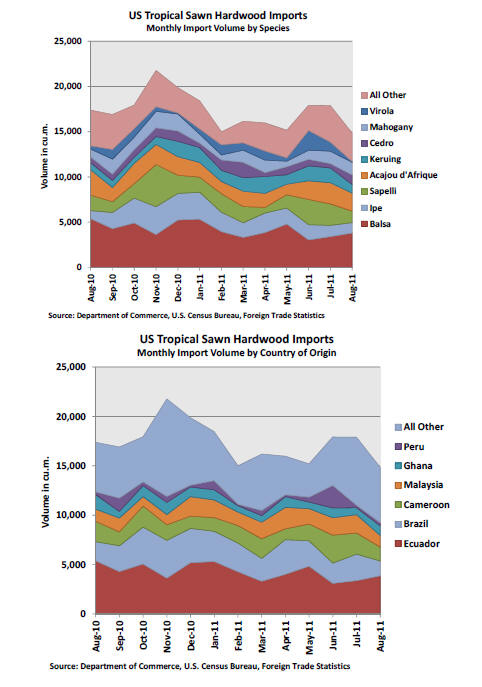
Plywood imports from China continue to rise
The US imported 255,187 cu.m. of hardwood plywood in
August, up from July but just 1% above 2010 on a year-todate
basis. 68% of all hardwood plywood imports this year
come from China, a significant increase from China¡¯s 59%
market share in 2010.
Shipments from Indonesia declined again after a brief
upswing in July. August imports from Indonsia were
10,713 cu.m. (-36% year-to-date). Malaysia shipped 5,435
cu.m. (-59% year-to-date) and Ecuador 3,868 cu.m. (-16%
year-to-date).

Brazil remains largest hardwood moulding supplier
Hardwood moulding imports declined to US$16.1 million
in August, but the import value remained 16% above 2010
on a year-to-date basis. Imports from China were US$5.7
million in August followed by Brazil with US$4.1 million.
More than a third of the US¡¯ total hardwood moulding
imports this year came from Brazil, while imports from
China account for 29%. Imports from Malaysia remained
at relatively high levels in August at US$1.5 million
(+44% year-to-date).
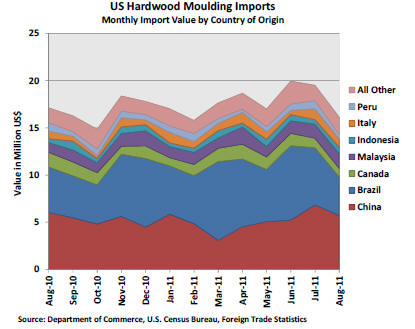
Strong growth in hardwood flooring imports
Hardwood flooring imports continued to increase despite
the slow US housing market and economic uncertainty.
US hardwood flooring imports were US$ 2.6 million in
August, a 60% year-to-date increase over 2010. There was
a shift in the sources of supply, however, with China
seemingly gaining market share from Malaysia in August.
China exported US$650,000 worth of hardwood flooring
in August, compared to Malaysia¡¯s US$234,000.
China¡¯s exports to the US remain far below pre-recession
levels, however, while Malaysia and Indonesia increased
shipments over the last two years. Malaysia doubled its
flooring exports to the US on a year-to-date basis from
2010, while Indonesia¡¯s almost tripled.
US Department proposes final anti-dumping duties on
engineered wood flooring from China
The US Department of Commerce has proposed antidumping
duties of up to 58.84% on multi-layer
(engineered) wood flooring from China.
A final ruling is expected in November. The anti-dumping
duties would replace the current preliminary
countervailing and anti-dumping duties on engineered
wood flooring from China.
The proposed duties are 58.84%, except for 74
manufacturers who would pay 3.31% and three other
exporters who were assessed duties of 3.98%, 3.31% and
0%, respectively. A coalition of US flooring importers and
retailers opposes the introduction of antidumping and
countervailing duties, stating that the duties would
threaten their businesses and American jobs.
Lacey Act Amendment ¨Cbipartisan legislation introduced
Congressman Jim Cooper and Marsha Blackburn, both of
Tennessee, have introduced a bill to amend the Lacey
Act. The bill received initial support from a wide range of
industries and groups such as the Audubon Society and a
variety of trade associations.
The International Wood Products Association (IWPA) has
signed on to a letter to Congressman Cooper say, ¡°IWPA
expresses its appreciation for the correct identification of
the issues the business community is facing as a result of
the Lacey Act.
The process is only beginning but we see this as an
excellent start in alleviating some of the unnecessary
burdens of Lacey Act while maintaining the spirit of the
Act.¡±
http://cooper.house.gov/index.php?option=com_content&task=vi
ew&id=537&Itemid=73
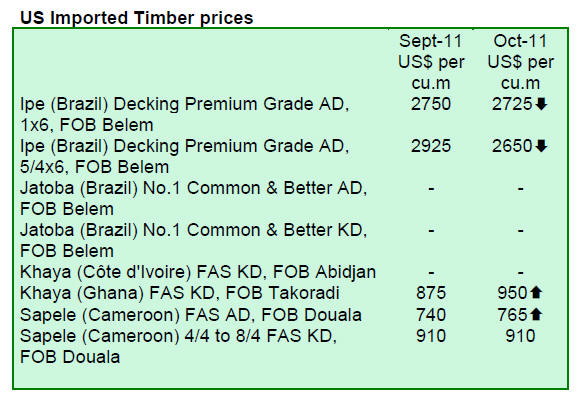
Related News:
|